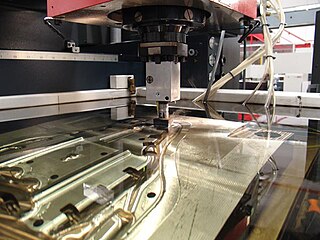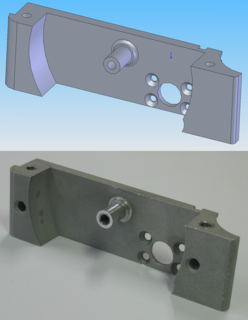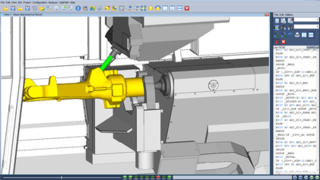
A simulation is the imitation of the operation of a real-world process or system over time. Simulations require the use of models; the model represents the key characteristics or behaviors of the selected system or process, whereas the simulation represents the evolution of the model over time. Often, computers are used to execute the simulation.

Electrical discharge machining (EDM), also known as spark machining, spark eroding, die sinking, wire burning or wire erosion, is a metal fabrication process whereby a desired shape is obtained by using electrical discharges (sparks). Material is removed from the work piece by a series of rapidly recurring current discharges between two electrodes, separated by a dielectric liquid and subject to an electric voltage. One of the electrodes is called the tool-electrode, or simply the tool or electrode, while the other is called the workpiece-electrode, or work piece. The process depends upon the tool and work piece not making physical contact.

Computer-aided manufacturing (CAM) also known as computer-aided modeling or computer-aided machining is the use of software to control machine tools in the manufacturing of work pieces. This is not the only definition for CAM, but it is the most common; CAM may also refer to the use of a computer to assist in all operations of a manufacturing plant, including planning, management, transportation and storage. Its primary purpose is to create a faster production process and components and tooling with more precise dimensions and material consistency, which in some cases, uses only the required amount of raw material, while simultaneously reducing energy consumption. CAM is now a system used in schools and lower educational purposes. CAM is a subsequent computer-aided process after computer-aided design (CAD) and sometimes computer-aided engineering (CAE), as the model generated in CAD and verified in CAE can be input into CAM software, which then controls the machine tool. CAM is used in many schools alongside computer-aided design (CAD) to create objects.
Process engineering is the understanding and application of the fundamental principles and laws of nature that allow humans to transform raw material and energy into products that are useful to society, at an industrial level. By taking advantage of the driving forces of nature such as pressure, temperature and concentration gradients, as well as the law of conservation of mass, process engineers can develop methods to synthesize and purify large quantities of desired chemical products. Process engineering focuses on the design, operation, control, optimization and intensification of chemical, physical, and biological processes. Process engineering encompasses a vast range of industries, such as agriculture, automotive, biotechnical, chemical, food, material development, mining, nuclear, petrochemical, pharmaceutical, and software development. The application of systematic computer-based methods to process engineering is "process systems engineering".

In machining, boring is the process of enlarging a hole that has already been drilled by means of a single-point cutting tool, such as in boring a gun barrel or an engine cylinder. Boring is used to achieve greater accuracy of the diameter of a hole, and can be used to cut a tapered hole. Boring can be viewed as the internal-diameter counterpart to turning, which cuts external diameters.
Incremental sheet forming is a sheet metal forming technique where a sheet is formed into the final workpiece by a series of small incremental deformations. However, studies have shown that it can be applied to polymer and composite sheets too. Generally, the sheet is formed by a round tipped tool, typically 5 to 20mm in diameter. The tool, which can be attached to a CNC machine, a robot arm or similar, indents into the sheet by about 1 mm and follows a contour for the desired part. It then indents further and draws the next contour for the part into the sheet and continues to do this until the full part is formed. ISF can be divided into variants depending on the number of contact points between tool, sheet and die. The term Single Point Incremental Forming (SPIF) is used when the opposite side of the sheet is supported by a faceplate and Two Point Incremental Forming (TPIF) when a full or partial die supports the sheet.
Cold sizing is a squeezing operation performed at temperatures significantly below the melting point to finish the surface of a workpiece to ensure better dimensional accuracy and surface finish.
Machining vibrations, also called chatter, correspond to the relative movement between the workpiece and the cutting tool. The vibrations result in waves on the machined surface. This affects typical machining processes, such as turning, milling and drilling, and atypical machining processes, such as grinding.

STEP-NC is a machine tool control language that extends the ISO 10303 STEP standards with the machining model in ISO 14649, adding geometric dimension and tolerance data for inspection, and the STEP PDM model for integration into the wider enterprise. The combined result has been standardized as ISO 10303-238.
Plant Simulation is a computer application developed by Siemens Digital Industries Software for modeling, simulating, analyzing, visualizing and optimizing production systems and processes, the flow of materials and logistic operations. Using Tecnomatix Plant Simulation, users can optimize material flow, resource utilization and logistics for all levels of plant planning from global production facilities, through local plants, to specific lines. Within the Plant Design und Optimization Solution the software portfolio, to which Plant Simulation belongs, is — together with the products of the Digital Factory and of Digital Manufacturing — part of the Product Lifecycle Management Software (PLM). The application allows comparing complex production alternatives, including the immanent process logic, by means of computer simulations. Plant Simulation is used by individual production planners as well as by multi-national enterprises, primarily to strategically plan layout, control logic and dimensions of large, complex production investments. It is one of the major products that dominate that market space.

Vericut, is a software program used for simulating CNC machining. It is used to simulate tool path motion and the material removal process, detecting errors or areas of inefficiency in NC programs. It was developed by CGTech Inc. and first released in 1988.

CNC plunge milling, also called z-axis milling, is a CNC milling process. In this process, the feed is provided linearly along the tool axis while doing CNC processing.

Freeform surface or complex surfaces are widely manufactured nowadays. The industries which most often manufactures free-form surfaces are basically aerospace, automotive, die mold industries, bio medical and power sector for turbine blades manufacturing. Generally 3 or 5 axis CNC milling machine is used for this purpose. The manufacturing process of free form surface is not an easy job as the tool path generation in present CAM technology is generally based on geometric computation so tool path are not optimum. The geometry can also be not described explicitly so errors and discontinuities occurrence in the solid structure cannot be avoided. Free-form surfaces are machined with the help of different tool path generation method like adaptive iso-planar tool path generation, constant scallop tool path generation, adaptive iso-parametric method, iso-curvature, isophote and by other methods. The different methods are chosen based on the parameters which is needed to be optimized.
This article is about CNC machine tool monitoring by AE sensors.
Digital manufacturing is an integrated approach to manufacturing that is centered around a computer system. The transition to digital manufacturing has become more popular with the rise in the quantity and quality of computer systems in manufacturing plants. As more automated tools have become used in manufacturing plants it has become necessary to model, simulate, and analyze all of the machines, tooling, and input materials in order to optimize the manufacturing process. Overall, digital manufacturing can be seen sharing the same goals as computer-integrated manufacturing (CIM), flexible manufacturing, lean manufacturing, and design for manufacturability (DFM). The main difference is that digital manufacturing was evolved for use in the computerized world.
Simulation in manufacturing systems is the use of software to make computer models of manufacturing systems, so to analyze them and thereby obtain important information. It has been syndicated as the second most popular management science among manufacturing managers. However, its use has been limited due to the complexity of some software packages, and to the lack of preparation some users have in the fields of probability and statistics.

Industrial augmented reality (IAR) is related to the application of augmented reality (AR) to support an industrial process. The use of IAR dates back to the 1990s with the work of Thomas Caudell and David Mizell about the application of AR at Boeing. Since then several applications of this technique over the years have been proposed showing its potential in supporting some industrial processes. Although there have been several advances in technology, IAR is still considered to be at an infant developmental stage.
Collaborative Control Theory (CCT) is a collection of principles and models for supporting the effective design of collaborative e-Work systems. Beyond human collaboration, advances in information and communications technologies, artificial intelligence, multi-agent systems, and cyber physical systems have enabled cyber-supported collaboration in highly distributed organizations of people, robots, and autonomous systems. The fundamental premise of CCT is: without effective augmented collaboration by cyber support, working in parallel to and in anticipation of human interactions, the potential of emerging activities such as e-Commerce, virtual manufacturing, telerobotics, remote surgery, building automation, smart grids, cyber-physical infrastructure, precision agriculture, and intelligent transportation systems cannot be fully and safely materialized. CCT addresses the challenges and emerging solutions of such cyber-collaborative systems, with emphasis on issues of computer-supported and communication-enabled integration, coordination and augmented collaboration. CCT is composed of eight design principles: (1) Collaboration Requirement Planning (CRP); (2) e-Work Parallelism (EWP); (3) Keep It Simple, System (KISS); (4) Conflict/Error Detection and Prevention (CEDP); (5) Fault Tolerance by Teaming (FTT); (6) Association/Dissociation (AD); (7) Dynamic Lines of Collaboration (DLOC); and (8) Best Matching (BM).

NCSIMUL is a software program developed by the company SPRING Technologies, that is used for simulating, verifying, and optimizing CNC machining in a 3-step process. It reads the post-processed G-code to identify the tool path, and replicates the material removal process of the machine by cutting volumes. It then identifies all syntax errors in the code, crashes in the machining environment, and deviations from the modeled CAD part.
Learning factories represent a realistic manufacturing environment for education, training, and research. In the last decades, numerous learning factories have been built in academia and industry.









